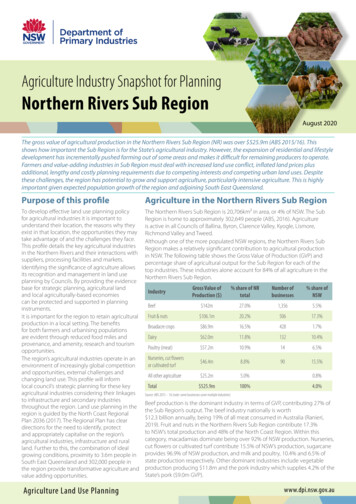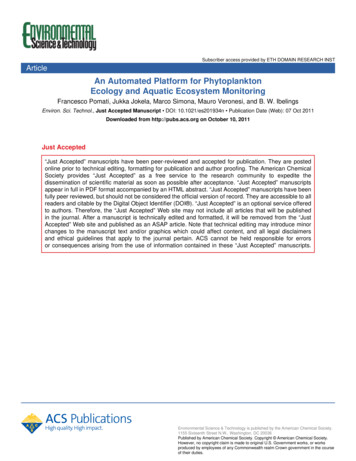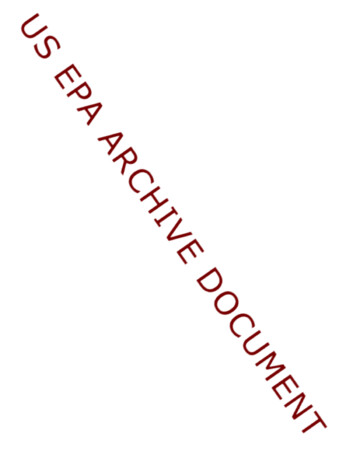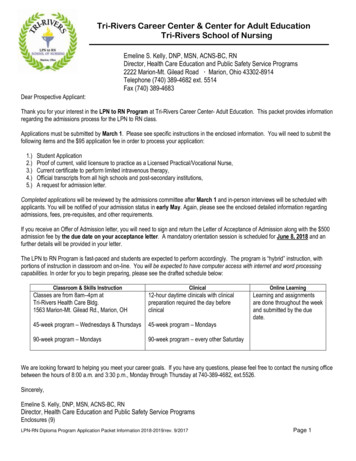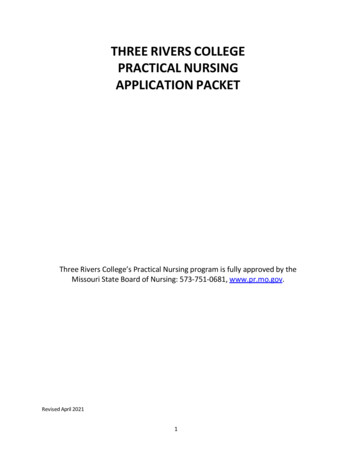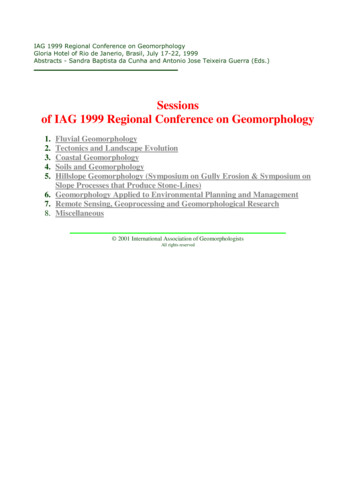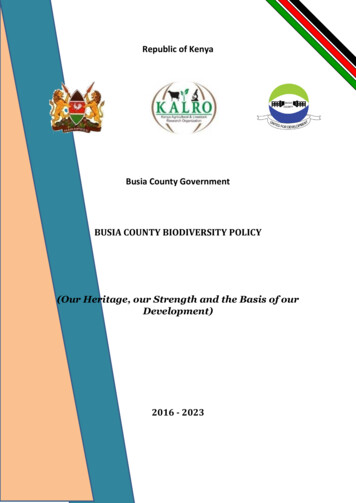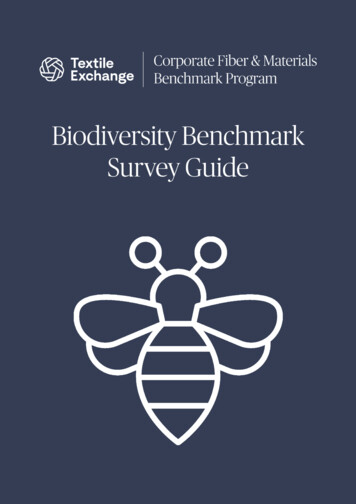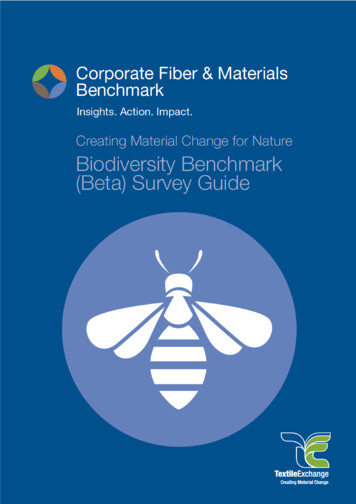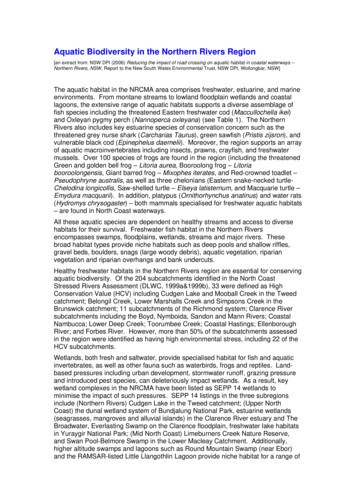
Transcription
Aquatic Biodiversity in the Northern Rivers Region[an extract from: NSW DPI (2006) Reducing the impact of road crossing on aquatic habitat in coastal waterways –Northern Rivers, NSW, Report to the New South Wales Environmental Trust, NSW DPI, Wollongbar, NSW]The aquatic habitat in the NRCMA area comprises freshwater, estuarine, and marineenvironments. From montane streams to lowland floodplain wetlands and coastallagoons, the extensive range of aquatic habitats supports a diverse assemblage offish species including the threatened Eastern freshwater cod (Maccullochella ikei)and Oxleyan pygmy perch (Nannoperca oxleyana) (see Table 1). The NorthernRivers also includes key estuarine species of conservation concern such as thethreatened grey nurse shark (Carcharias Taurus), green sawfish (Pristis zijsron), andvulnerable black cod (Epinephelus daemelii). Moreover, the region supports an arrayof aquatic macroinvertebrates including insects, prawns, crayfish, and freshwatermussels. Over 100 species of frogs are found in the region (including the threatenedGreen and golden bell frog – Litoria aurea, Booroolong frog – Litoriabooroolongensis, Giant barred frog – Mixophes iterates, and Red-crowned toadlet –Pseudophryne australis, as well as three chelonians (Eastern snake-necked turtleChelodina longicollis, Saw-shelled turtle – Elseya latisternum, and Macquarie turtle –Emydura macquarii). In addition, platypus (Ornithorhynchus anatinus) and water rats(Hydromys chrysogaster) – both mammals specialised for freshwater aquatic habitats– are found in North Coast waterways.All these aquatic species are dependent on healthy streams and access to diversehabitats for their survival. Freshwater fish habitat in the Northern Riversencompasses swamps, floodplains, wetlands, streams and major rivers. Thesebroad habitat types provide niche habitats such as deep pools and shallow riffles,gravel beds, boulders, snags (large woody debris), aquatic vegetation, riparianvegetation and riparian overhangs and bank undercuts.Healthy freshwater habitats in the Northern Rivers region are essential for conservingaquatic biodiversity. Of the 204 subcatchments identified in the North CoastStressed Rivers Assessment (DLWC, 1999a&1999b), 33 were defined as HighConservation Value (HCV) including Cudgen Lake and Mooball Creek in the Tweedcatchment; Belongil Creek, Lower Marshalls Creek and Simpsons Creek in theBrunswick catchment; 11 subcatchments of the Richmond system; Clarence Riversubcatchments including the Boyd, Nymboida, Sandon and Mann Rivers; CoastalNambucca; Lower Deep Creek; Toorumbee Creek; Coastal Hastings; EllenboroughRiver; and Forbes River. However, more than 50% of the subcatchments assessedin the region were identified as having high environmental stress, including 22 of theHCV subcatchments.Wetlands, both fresh and saltwater, provide specialised habitat for fish and aquaticinvertebrates, as well as other fauna such as waterbirds, frogs and reptiles. Landbased pressures including urban development, stormwater runoff, grazing pressureand introduced pest species, can deleteriously impact wetlands. As a result, keywetland complexes in the NRCMA have been listed as SEPP 14 wetlands tominimise the impact of such pressures. SEPP 14 listings in the three subregionsinclude (Northern Rivers) Cudgen Lake in the Tweed catchment; (Upper NorthCoast) the dunal wetland system of Bundjalung National Park, estuarine wetlands(seagrasses, mangroves and alluvial islands) in the Clarence River estuary and TheBroadwater, Everlasting Swamp on the Clarence floodplain, freshwater lake habitatsin Yuraygir National Park; (Mid North Coast) Limeburners Creek Nature Reserve,and Swan Pool-Belmore Swamp in the Lower Macleay Catchment. Additionally,higher altitude swamps and lagoons such as Round Mountain Swamp (near Ebor)and the RAMSAR-listed Little Llangothlin Lagoon provide niche habitat for a range of
aquatic species, as well as for several threatened species of birds, amphibians, andplants.Aquatic habitat rehabilitation, in particular reinstating stream connectivity, is essentialfor maintaining aquatic biodiversity and protecting the integrity of rivers, lakes andwetlands in coastal NSW.Figure 1: The Northern Rivers CMAregion exhibiting 3rd order and abovewater ways. Divisions shown fromnorth to south are the Northern Rivers,Upper North Coast and Mid NorthCoast subregions.For the whole document, seeNSW DPI (2006) Reducing the impact of road crossing on aquatic habitat in coastal waterways – Northern Rivers,NSW, Report to the New South Wales Environmental Trust, NSW DPI, Wollongbar, NSWReferences in this extract:NSW Department of Land and Water Conservation (1999a) Stressed Rivers Assessment Report: North Coast Region- Nambucca, Macleay and Hastings, Camden Haven Catchments. DLWC, SydneyNSW Department of Land and Water Conservation (1999b) Stressed Rivers Assessment Report: Region North Coast– Tweed, Brunswick and Richmond Catchments. DLWC, Sydney.
Table 1: Freshwater and estuarine fish in the North Coast NSWScientific mTamar RivergobyAmbassisagassiziiOlive perchletEstuaryperchletMigration1 and habitatCommonAmphidromous; coastal marine; estuaries andinshore reefsCommonEstuaries, coastal lakes and lower freshwaterriver reachesSilver hreatened species Endangered westernpopulationCommonGlass perchletLocal migration; freshwater streams, ponds andswampsLocal migration; brackish mangrove estuariesand tidal creeksAmniatabapercoidesBanded grunterExotic;Noxious listing, NSWAnguilliaaustralisShort-finned eelCommonCatadromous; coastal rivers & wetlandsCommonCatadromous; coastal riversAnguillareinhardtiiLong-finned eelMarbled eelFreshwater habitatsAnnoyabifrenatusBridled gobyCommonEstuaries and marine watersArius us; northern coastal coastal bays and brackish adCommonUnknown migration pattern; coastal estuarineand fresh watersButis butisBony-snoutedgudgeonReasonablyabundant in rangeCarassiusauratusGoldfishExoticChanos chanosMilkfishCommonMarine and warm water, shallow estuaries headUncertainUnknown migration pattern; found in abundancein fresh waters of the Clarence & Mary Rivers –few elsewhere.Cyprinus carpioCommon carpEpinepheluscoioidesEstuary codRock codExotic;Noxious ious kish waters and coastal riversWidespread in lowland riversStill gentle flowing rivers in inland NSW andsome catchments along the coast.Marine – found mainly in reefy inshore watersand estuariesWidespread in coastal and inland NSWCatadromous; coastal streams, lakes andlagoons – salt and fresh water environsMigration patterns of freshwater fish include: Potamodromous – fish that migrate wholly within fresh water;Anadromous – fish that spend most of their life in the sea and migrate to fresh water to breed; Catadromous - fishthat spend most of their life in fresh water and migrate to the sea to breed; Amphidromous - fish that migratebetween sea and fresh water, but not for the purpose of breeding.
Galaxias olidusMountaingalaxiasCommonLocal migration; moderate and high elevations incoastal and inland rivers.GerressubfasciatusSilver biddyCommonMarine estuaries and bays, brackish coastalrivers and lakes.GlossamiaaprionMouth almightyGobiomorphusaustralisAbundant within itsrangeLocal migration; northern freshwater streams,ponds and reservoirsStripedgudgeonCommonAmphidromous; coastal streams generally atlower elevations.GobiomorphuscoxiiCox’s gudgeonCommonPotamodromous; coastal rivers from theRichmond River south.GobiopterussemivestitusGlass udgeonCommon throughoutits odromous; freshwater reaches of coastalstreams.HypseleotrisklunzingeriWestern carpgudgeonCommonUnknown migration; inland and north coaststreamsLeiopotheraponunicolorSpangled perchCommonPotamodromous; warm fresh waters in inlandand north coast streams, backwaters and dams.Liza argenteaFlat-tail mulletCommonEstuaries and sea beachesMaccullochellaikeiEasternfreshwater codThreatened Species– EndangeredMacquariacolonorumEstuary perchUncertainAmphidromous; estuarine areas in coastal riversand lakesMacquarianovemaculeataAustralian bassUncertainCatadromous; Coastal rivers up to 600maltitude.MegalopscyprinoidesOxeye herringAbundant throughoutits rangeAmphidromous; tropical waters, estuaries andnorthern coastal fresh Relatively commonthroughout its rangeLocal migration; coastal waterways fromMacleay River north into QLDMogurndaadspersaPurple-spottedgudgeonThreatened Specieslisting - Endangeredwestern populationLocal migration; inland NSW and coastalstreams of northern NSW and QLDMugil cephalusStriped mulletSea mulletUnknown migration; lower reaches of coastalrivers.Unknown migration; restricted to the Clarenceand Richmond catchmentsCommonAmphidromous; lower reaches and estuaries ofcoastal catchmentsMyxus elongatusSand mulletCommonAmphidromous as juveniles; estuaries andbrackish waters in lower river reachesMyxus petardiFreshwatermulletCommonCatadromous; freshwater reaches of coastalrivers north of Georges River into QLDNannopercaoxleyanaOxleyan pygmyperchThreatened Species– EndangeredLocal migration; some northern streams andswampy areas.NotesthesrobustaBullroutLimited abundancebut not threatenedCatadromous; tidal estuaries and fresh watersOncorhynchusmykissRainbow monLocal migration; montane regions along theGreat Dividing RangeUnknown migration; inland and coastal watersespecially lakes and dams
Philypnodonsp.1Dwarf flatheadgudgeonCommonUnknown migration; coastal and inland streamsPlatycephalusfuscusDusky flatheadCommonAmphidromous; marine and estuarine ugilsigniferSouthern blueeyeCommonAmphidromous; eastern draining Amphidromous; estuaries, coastal rivers andsome freshwater dromous; Inland and coastal shPatchy fishCommonLocal migration; lakes and slow-flowing riversValamugilgeorgiiFantail mulletCommonAmphidromous as juveniles; marine andestuarine watersNot common but notconsidered underthreatCatadromous; estuaries and coastal fresh waterriversLocal migration; northern coastal streamsSources:Allen G.R., Midgley, S.H. & Allen M. (2002) Field guide to the freshwater fishes of Australia. WesternAustralian Museum, Perth.McDowall, R.M (1996) Freshwater fishes of south-eastern Australia. Reed Books, Sydney.Thorncraft, G. and Harris, J.H. (2000) Fish passage and fishways in NSW: A Status Report. CooperativeResearch Centre for Freshwater Ecology Technical Report 1/2000.Yearsley G.K., Last P.R. & Ward R.D. (2001) Australian Seafood Handbook – Domestic Species.CSIRO Marine Research and Fisheries Research & Development Corporation, Aust.
NSW Department of Land and Water Conservation (1999b) Stressed Rivers Assessment Report: Region North Coast - Tweed, Brunswick and Richmond Catchments. DLWC, Sydney. Figure 1: The Northern Rivers CMA region exhibiting 3rd order and above water ways. Divisions shown from north to south are the Northern Rivers, Upper North Coast and Mid North
